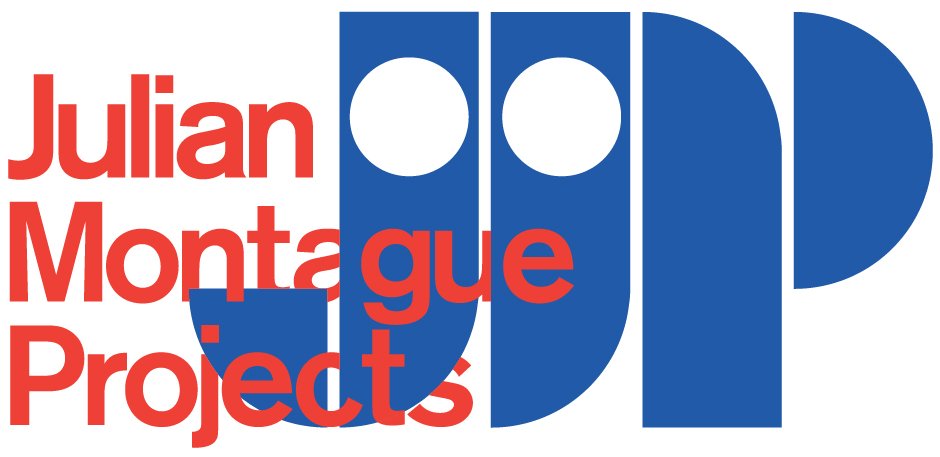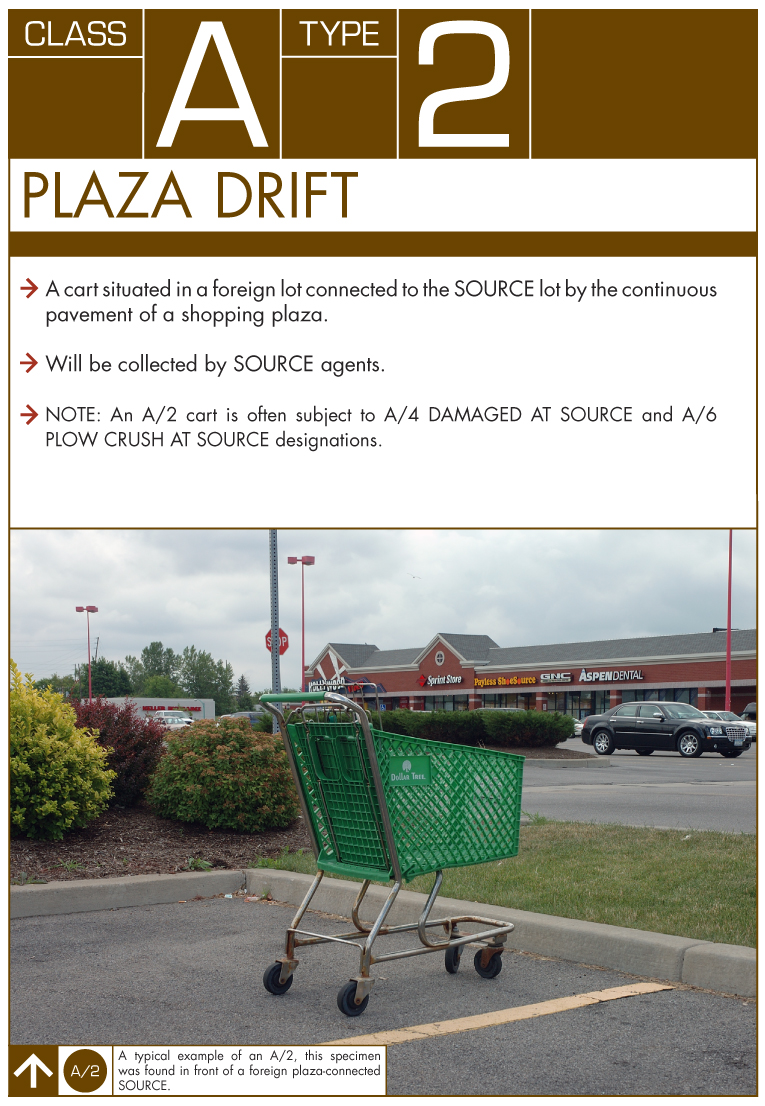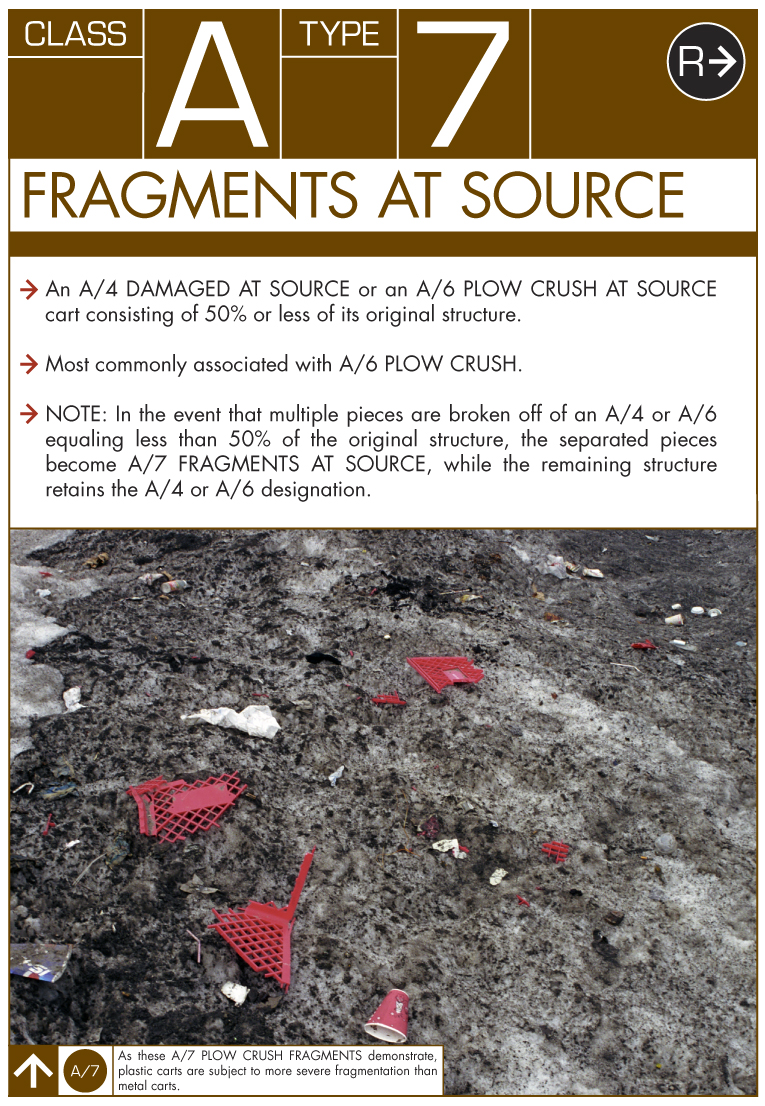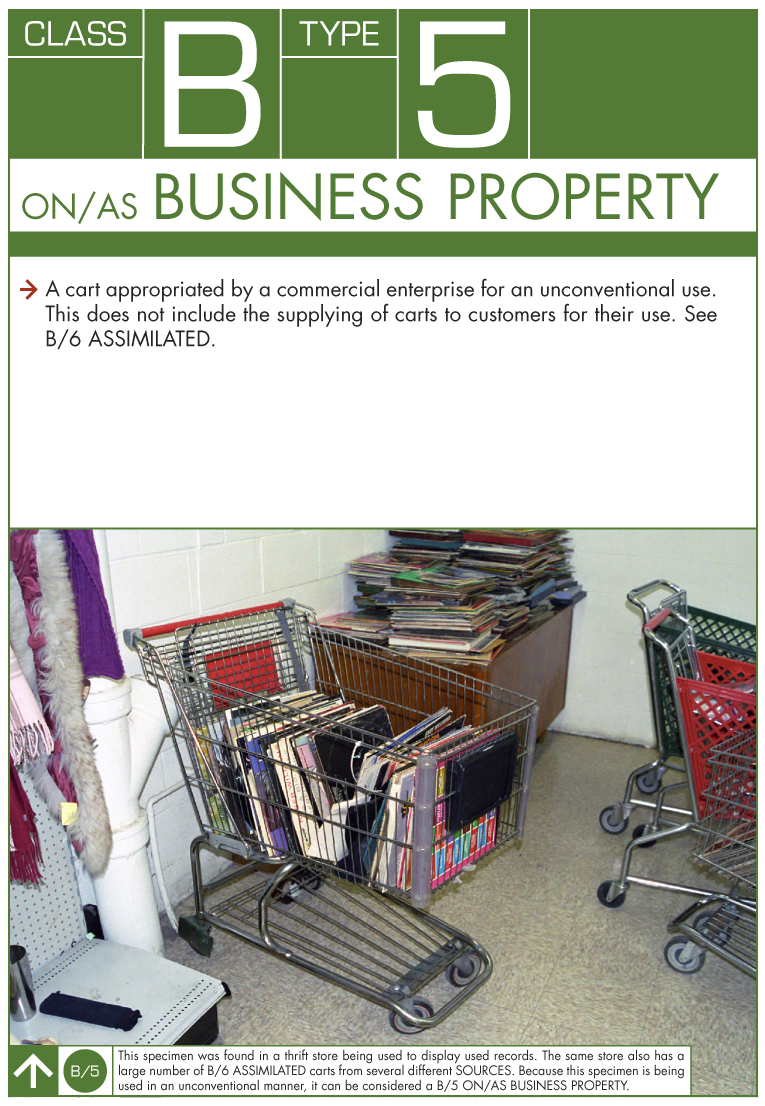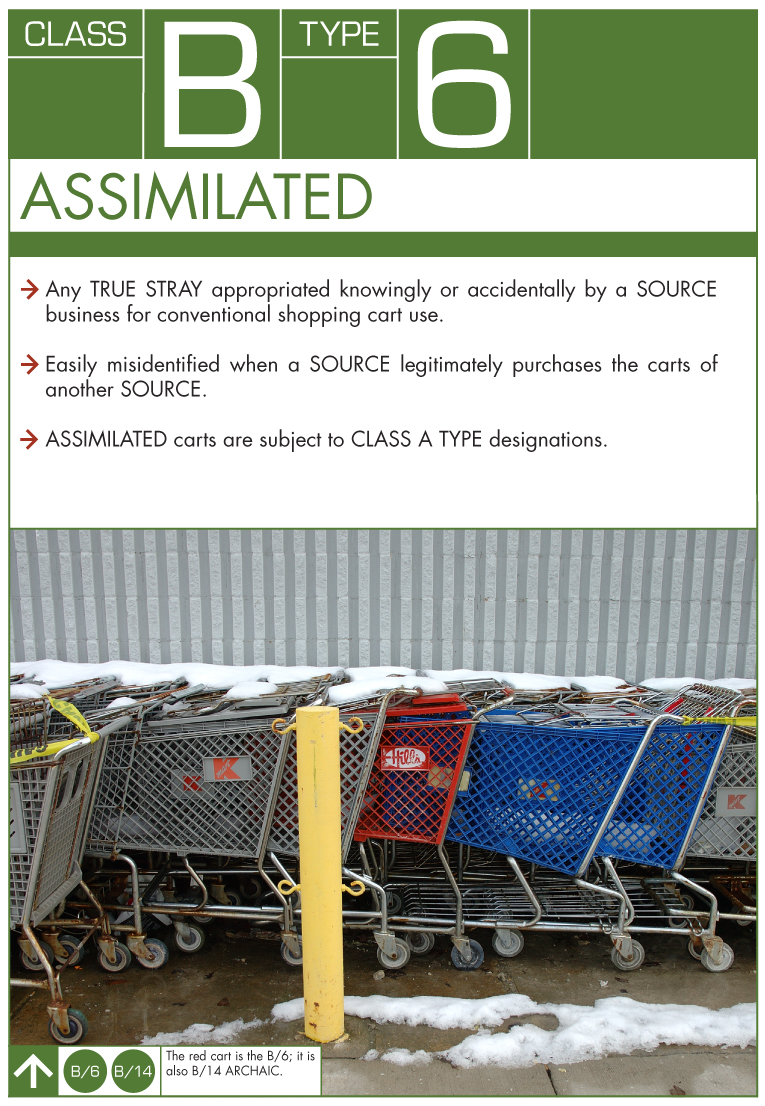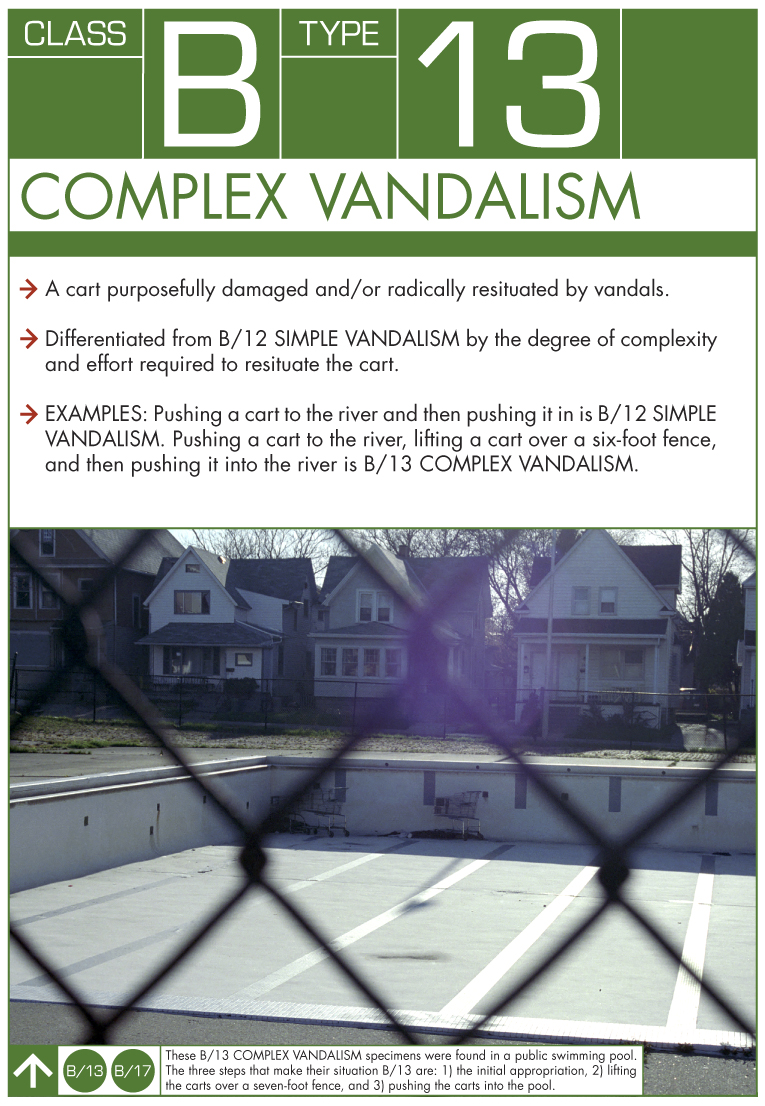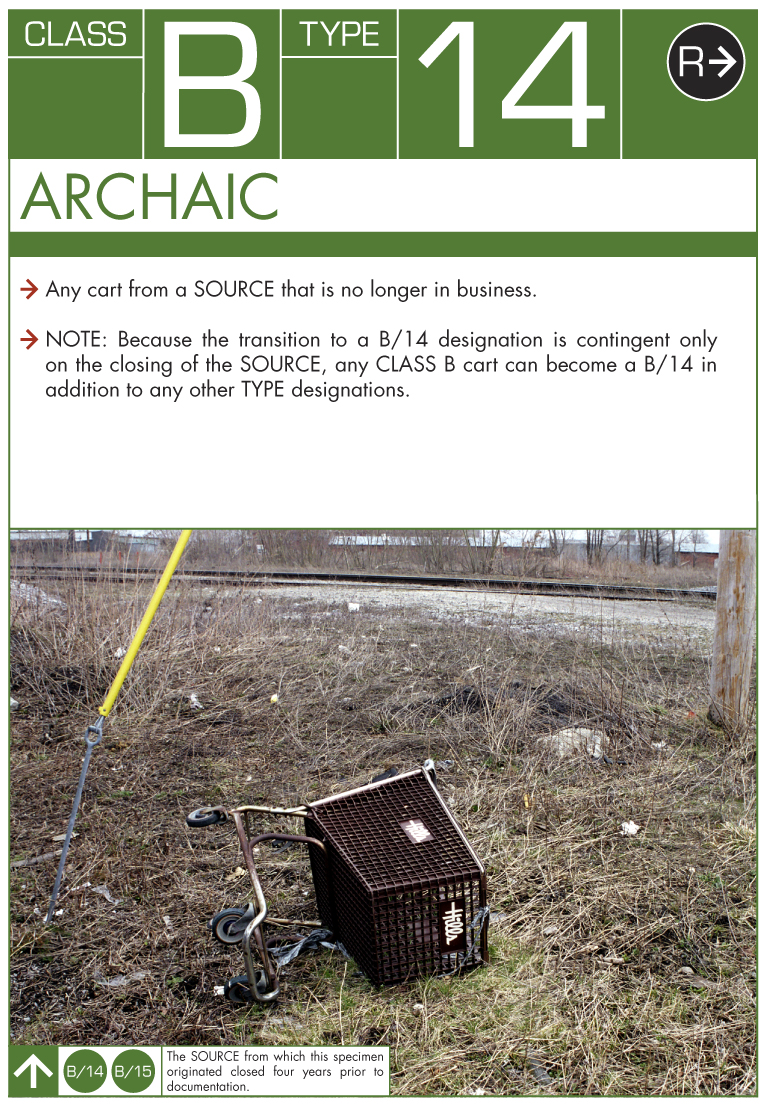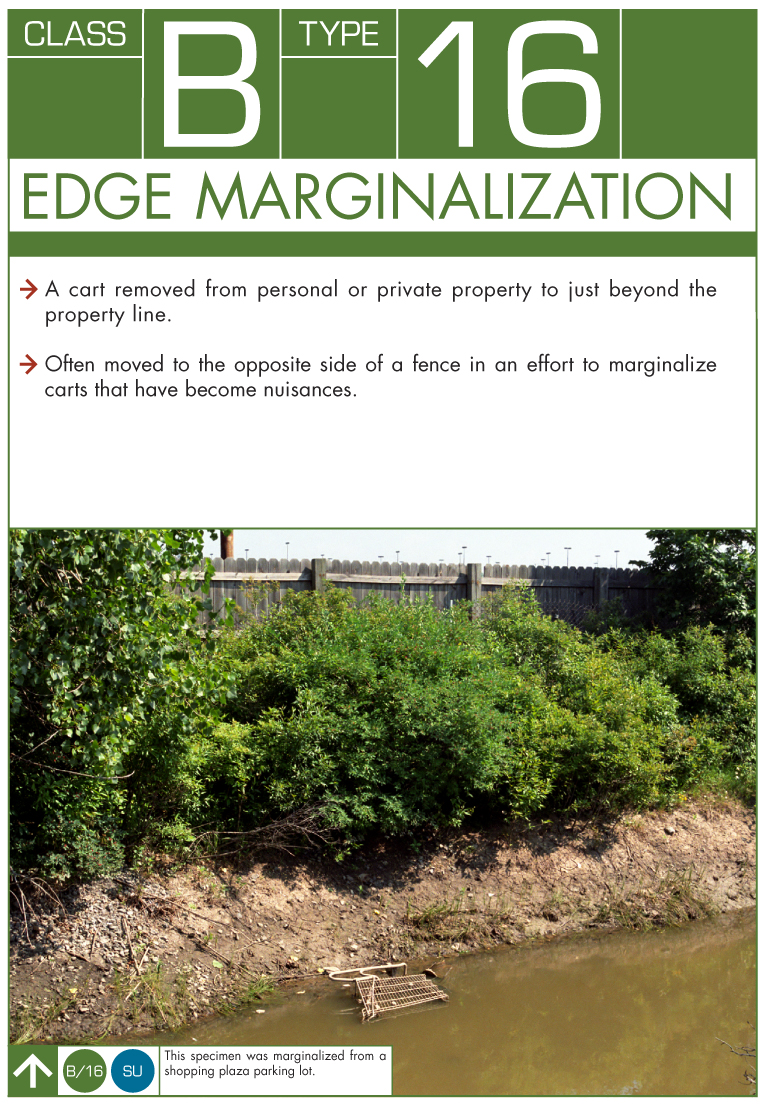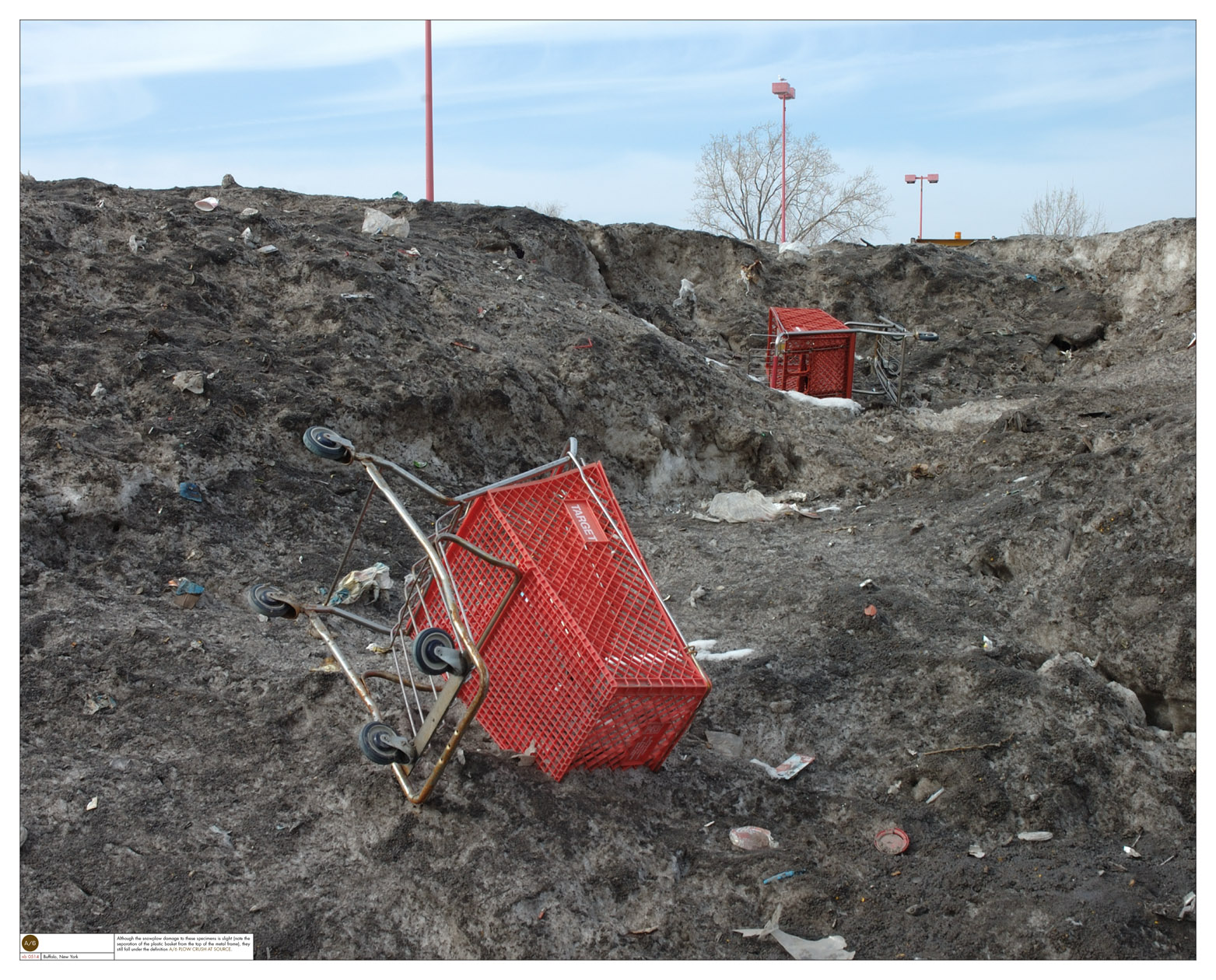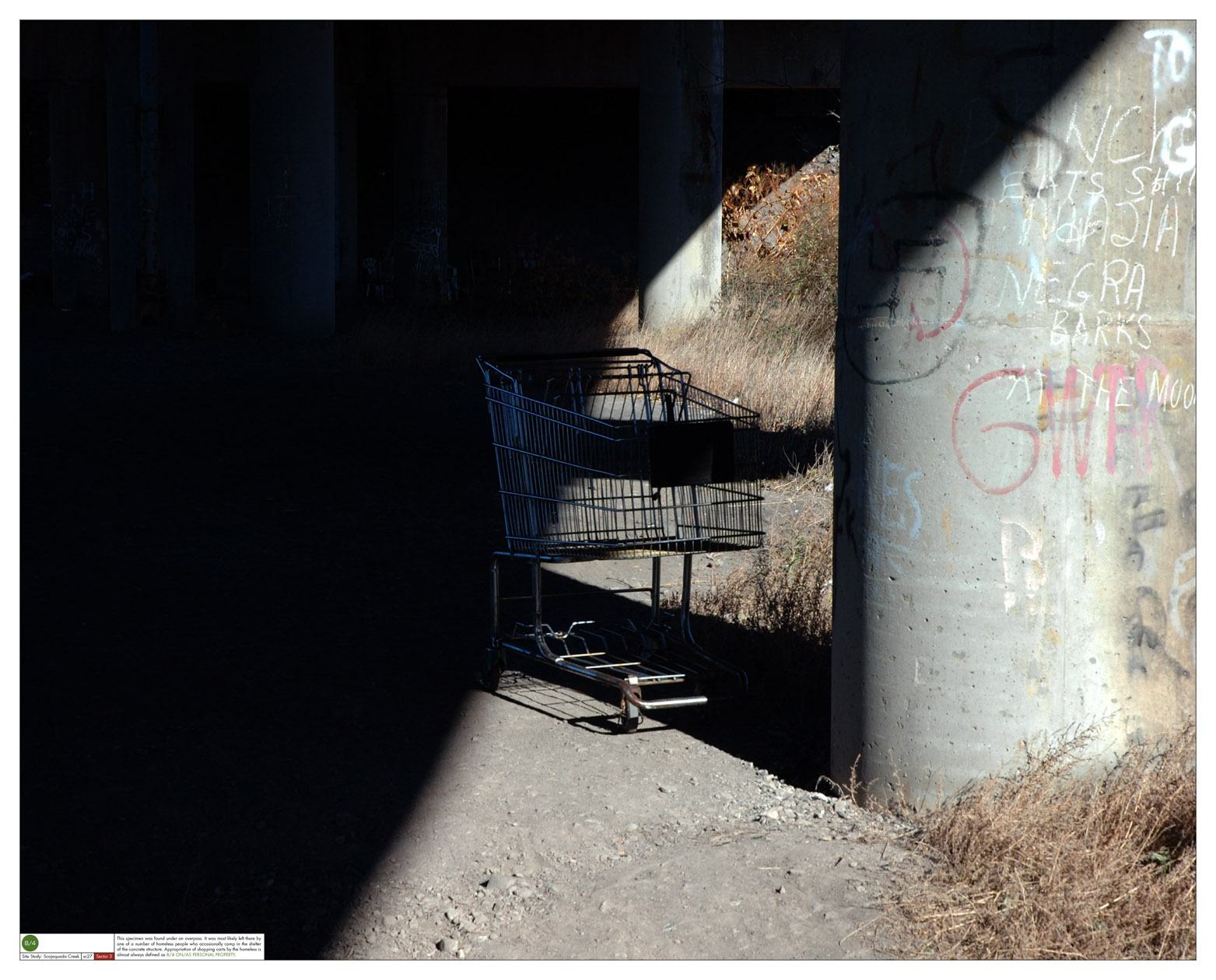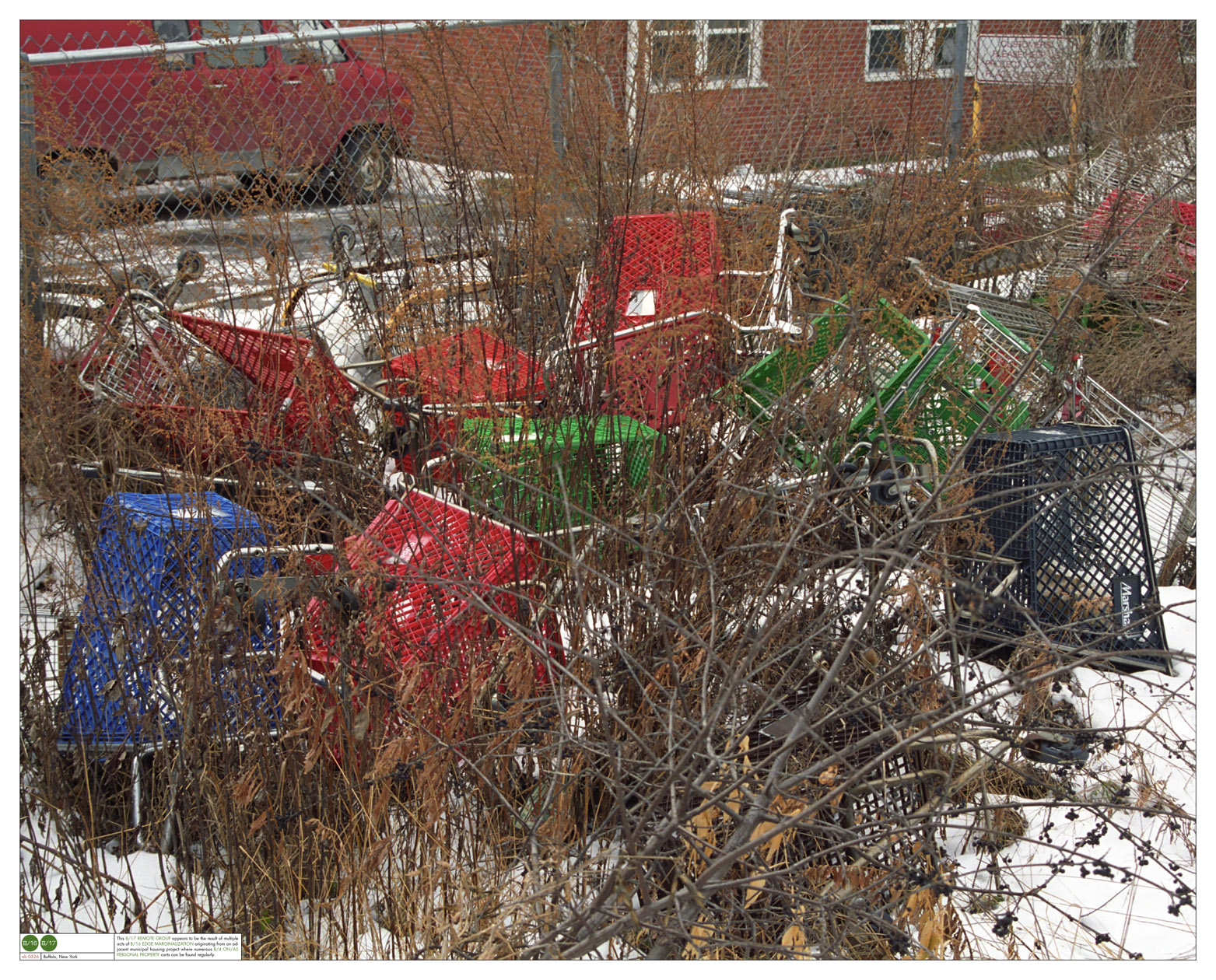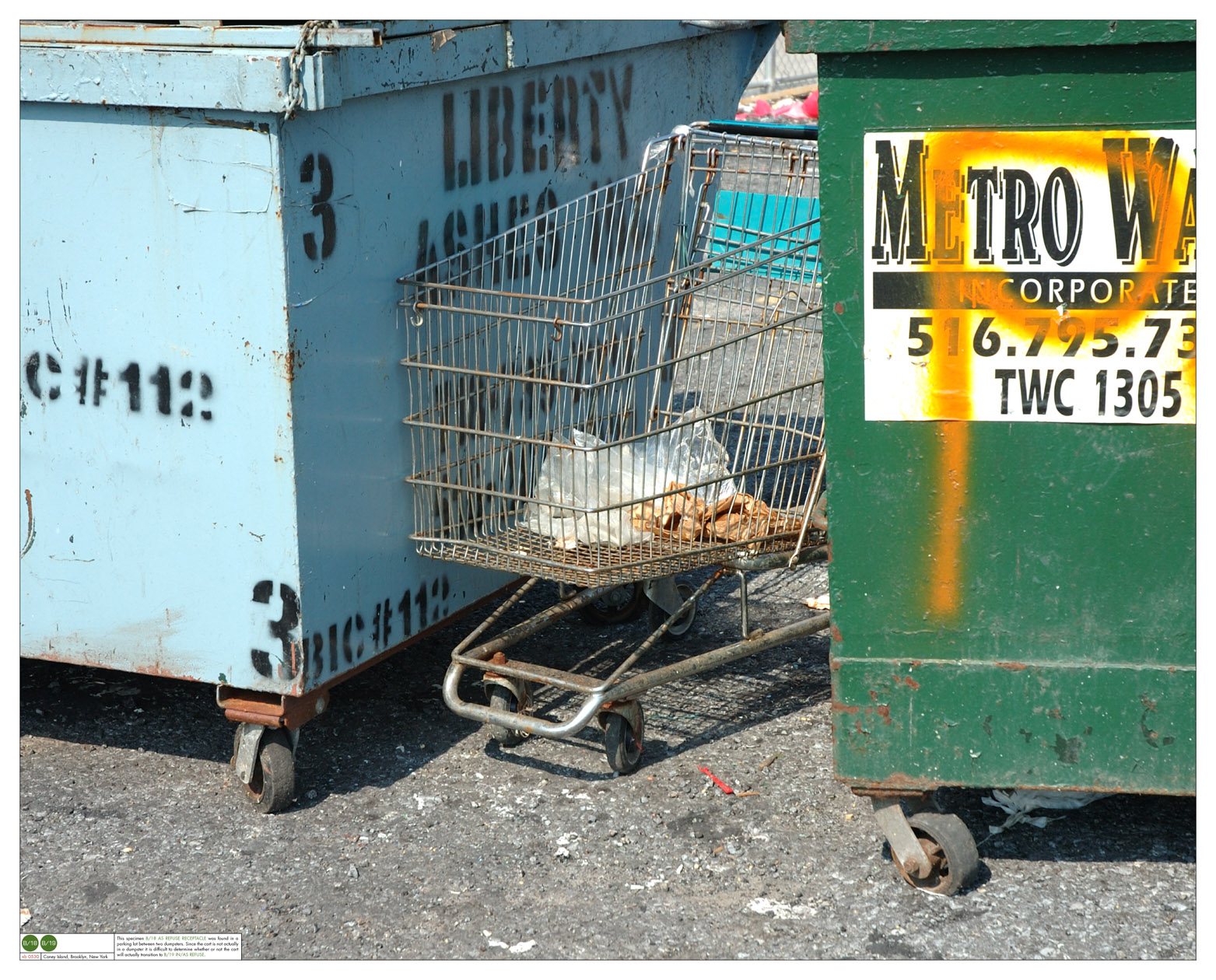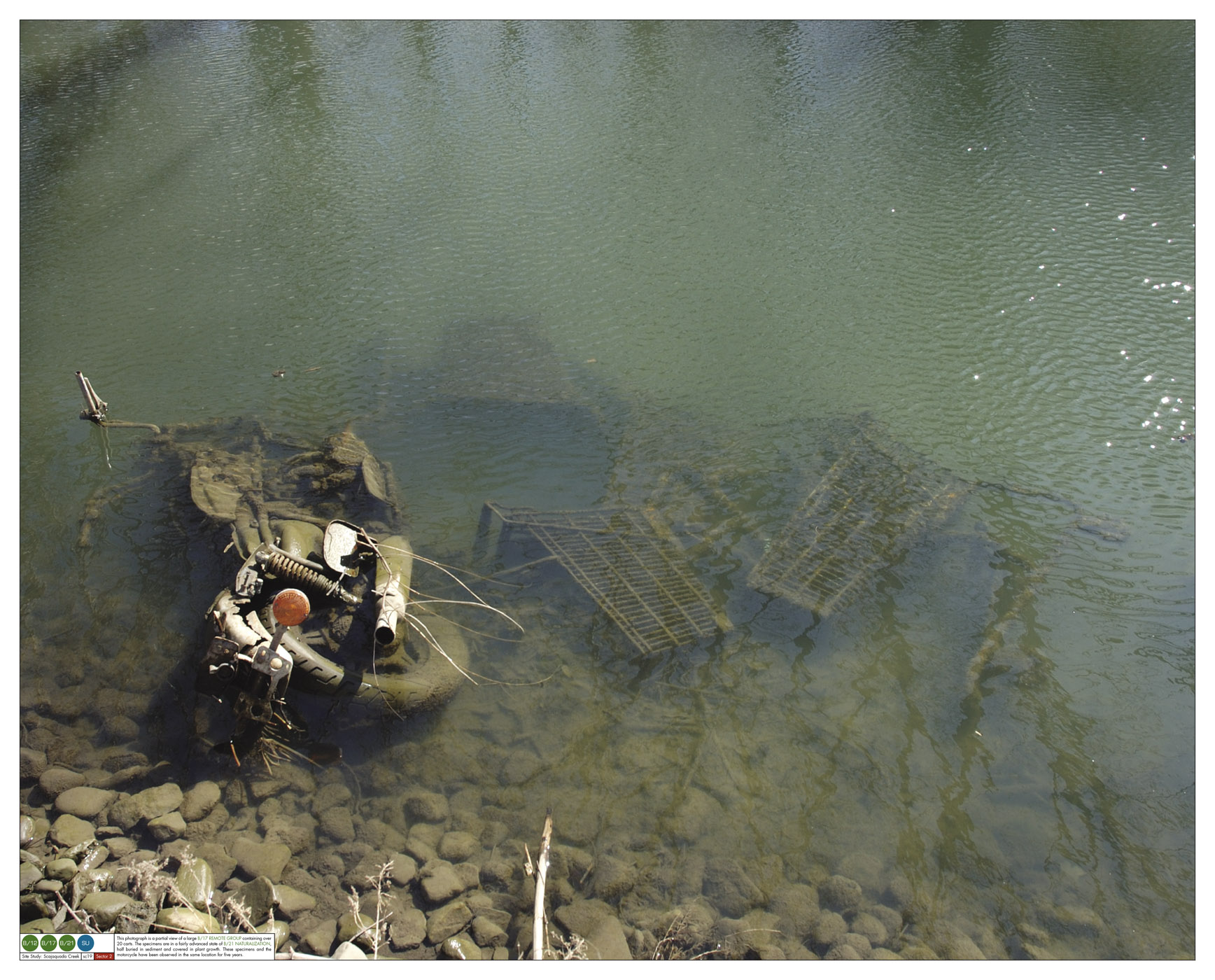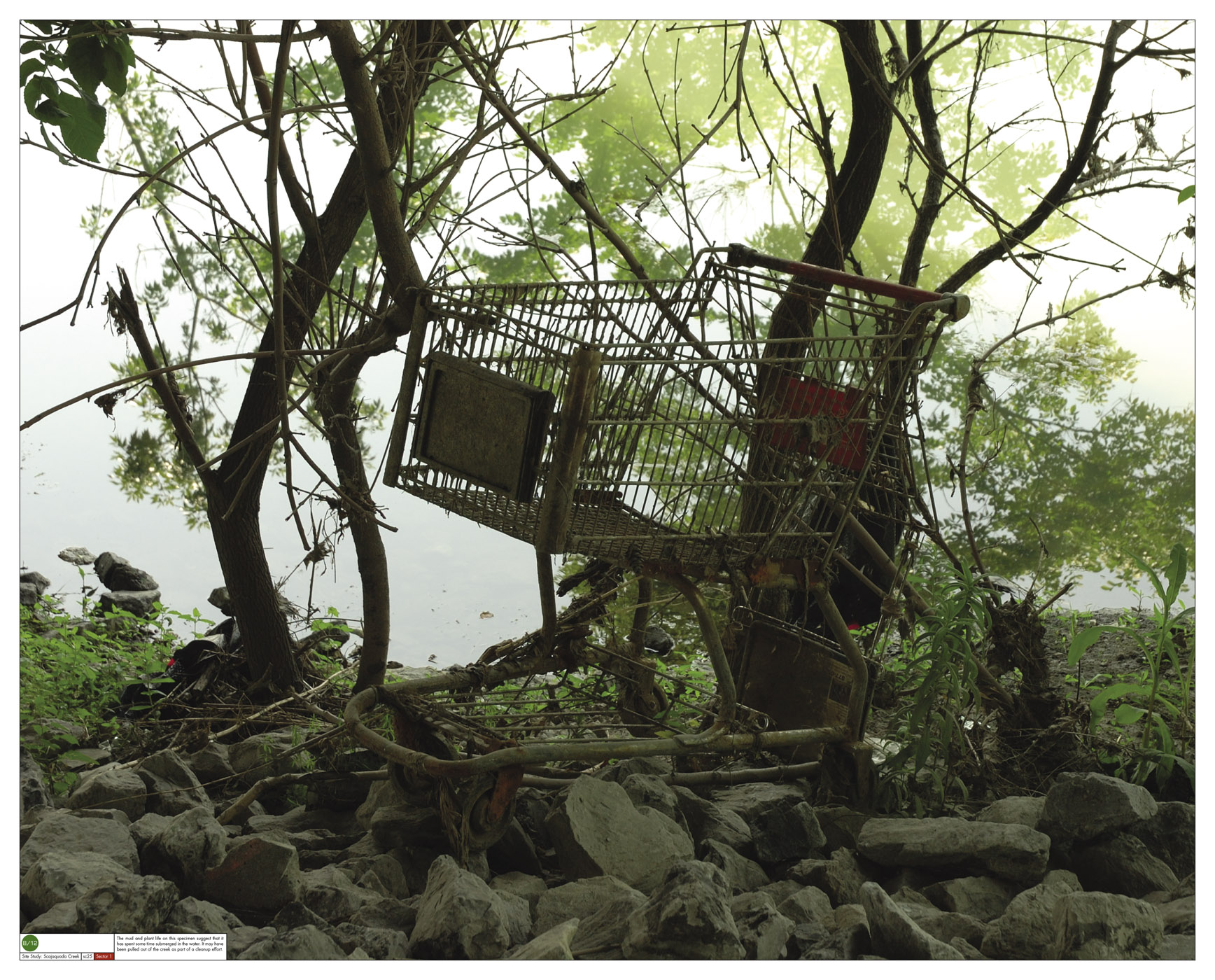The Stray Shopping Cart Project
I have recently updated and redesigned this project for the publication of The Stray Shopping Carts of Eastern North America: A Guide to Field Identification, Revised Edition (University of Chicago Press 2023). Eventually I will update the elements below to reflect that, but in the meantime this page represents the project as it was from 1999 to 2008.
Concept & History
At some point in 1999 it struck me that there was an interesting art project to be done about the stray shopping carts I was seeing around my city. I knew from the beginning that if I were to just take pictures of carts in the urban environment, the work would read as fairly conventional social documentary photography, (a genre I am not terribly fond of). I thought that to get beyond those conventions I would need to approach the stray shopping cart phenomenon from a different angle. I decided to try to define the different states in which a stray cart could be. This led to a rudimentary system of classification that described what I then saw as the basic thirteen types. My approach was to observe the stray cart in the way that a naturalist might observe an animal. I never posed or repositioned or interfered with stray carts. I thought of the human actors as unseen natural forces (people almost never appear directly in any of the project photographs). I wrote the text from the point of view of someone who took the taxonomic investigation of stray shopping carts extremely seriously. That character (the fictional Julian Montague) became more important as the project proceeded, and the conceptual space of the work became strictly defined.
As the project moved forward and I was given opportunities to show it, I was continually refining the system based on new observations. Over the active years of the project I documented and categorized thousands of stray shopping carts in the United States and abroad. The system evolved to include thirty-three types that can be used singly or in combination to describe and thereby “identify” any found cart.
Although it was not clear to me in the early stages, I soon realized that the project was exploration of the ways in which language and scientific systems of classification shape our perception of both the natural and man made worlds. By establishing an authoritative voice that names the unnamed and articulates (in absurd detail) the workings of a mundane phenomenon, the project can manipulate the viewer’s perception of stray shopping carts by developing a sensitivity to them.
Exhibitions/Installation/Publication
The project has been exhibited in a number of different ways. The first presentation of the System as a set of prints in a gallery space was in 2002. At the time this consisted of non-archival inkjet prints pinned to the gallery walls with t-pins. Each Type in the System was a separate print with further examples of each Type taking the form of smaller prints connected by lines of association. Other sections included Selected Specimens and Site Studies. While this was not the best way to make a lasting body of work, the method was within my means at the time and it was flexible enough that it could fill different types of gallery spaces.
In late 2004 I began enlarging specimen images to 25"x31" and having them printed as light jet prints (The prints are face mounted to Plexiglas and backed with sintra.). Each image has the Type designation icons and a note about its situation in the lower left hand corner of the piece. I reconfigured all of the System information to fit on one 35"x40" chart (see System Chart).
My September 2006 solo show at Black and White gallery was the first time I made use of vinyl lettering and graphic tape to connect the language of the project to the individual pieces. I repeated this approach on a smaller scale at the Margulies collection in December 2006, and at several other venues since then.
The only foray into outdoor sculpture with this project took place at Socrates Sculpture Park in the Spring of 2008. It was also a departure from my normal practice in that I was staging stray cart situations instead of documenting them in the real world. More here.
Elements of the the Stray Shopping Cart Project have appeared in print in a number of different ways. I make a distinction between pieces that are in the conceptual "voice" of the project and those that are about the project, exhibition catalogs, etc. My book, The Stray Shopping Carts of Eastern North America: A Guide to Field Identification, represents the most complete conceptual manifestation of the project. It also has the distinction of winning the Diagram/Booksellers Prize for the oddest Title of the Year 2006.
Understanding the System
In order to encourage a more nuanced and comprehensive understanding of the phenomenon, I have worked for the past six years to develop a system of identification for stray shopping carts. Unlike a Linaean taxonomy, which is based on the shared physical characteristics of living things, this system works by defining the various states and situations in which stray shopping carts can be found. The categories of classification were arrived at by observing shopping carts in different situations and considering the conditions and human motives that have placed carts in specific situations and the potential for a cart to transition from one situation to another.
The resulting Stray Shopping Cart Identification System consists of two classes and thirty-three subtypes that can be used singly or in combination to describe and thereby “identify” any found cart. One of the unfortunate difficulties in implementing a situational taxonomy of this kind is that one is often required to speculate about where a cart is coming from and where it is going next. While this uncertainty can at times be vexing, it must be remembered that this system is the first attempt to categorize and analyze the transient nature of the shopping cart. The refinement of this system is an ongoing process.
Notes on Identification
Because the Stray Shopping Cart Identification System considers the situation a stray cart is in and the potential to transition to new situations, it is often not possible to assign Type designations with complete certainty. Some Types, B/2 DAMAGED for example, describe the physical condition the stray cart is in; consequently it is relatively easy to assign the B/2 Type designation. Types that describe a cart’s situation in a larger context (A/9 REMOTE FALSE, B/1 OPEN TRUE, and many others) cannot be assigned with certainty without actively tracking the cart for days or weeks. With long-term tracking often being out of the question, the observer should take into account the context in which he/she finds the cart and construct a likely hypothesis.
One must keep in mind that a number of Types have significant overlap in their definitions. For example, a B/3 FRAGMENT is by definition also a B/2 DAMAGED. Similarly, B/10 PLOW CRUSH and B/11 TRAIN DAMAGED are also B/2 DAMAGED. The overlap is useful in situations where the specific cause of the damage cannot be determined. In such cases, the B/2 Type alone should be assigned. At some level, it would be correct to think of B/3, B/10, B/11, and B/20 as subtypes of B/2. However, given that this System is based on the situation in which a cart is found, these Types must be separate. When assigning Type designations, it is not necessary to assign redundant Types. For example, one does not need to assign B/2 DAMAGED as well as B/10 PLOW CRUSH.
Another aspect of the identification process is that a cart may hold multiple Type designations. For example, a B/14 Archaic cart can simultaneously be a B/10 PLOW CRUSH. Some Type designations, once acquired by a specimen, are retained (indicated by the R–Arrow icon) throughout all subsequent transitions, while others are lost when a transition occurs. For example, if a B/3 FRAGMENT is thrown in the trash, it will acquire the B/19 IN/AS REFUSE designation, but it will still retain the B/3 designation. When a B/4 ON/AS PERSONAL PROPERTY is removed from personal property, the designation is not retained. A general rule is that physically damaged or modified carts retain the Types that affected them, while those Types based purely on the situational context in which they are found are lost when a transition to a new situation occurs. One Type outside of this dichotomy is B/14 Archaic, which is always retained since it is defined by the irreversible event of its SOURCE of origin closing.
CLASS A Types can be subject to some CLASS B Types. A common example is that when an A/1 CLOSE FALSE is vandalized at the edge of the SOURCE lot, it acquires the secondary Type of B/12 SIMPLE VANDALISM. Such situations are indicated by a green icon with a brown border. A CLASS B cart can acquire a CLASS A Type only when a B/1 OPEN TRUE is left at a bus stop, where it becomes A/3 BUS STOP DISCARD.
CLASS A: FALSE STRAYS
1. A shopping cart that while on the SOURCE lot is diverted from its primary function, damaged, or otherwise rendered useless.
2. A shopping cart that appears to be a stray cart but that is ultimately returned to service in the SOURCE from which it originated.
CLASS B: TRUE STRAYS
1. A cart that will not be returned to the SOURCE from which it originated.
2. CLASS B: TRUE STRAY types may be used as secondary designations for CLASS A: FALSE STRAY specimens.
SELECTED EXHIBITION PRINTS
SITE STUDY
All this and much more can be found in The Stray Shopping Carts of Eastern North America: A Guide to Field Identification available on Amazon (the reviews are pretty funny) and probably at your local bookshop if you ask them to order it.
